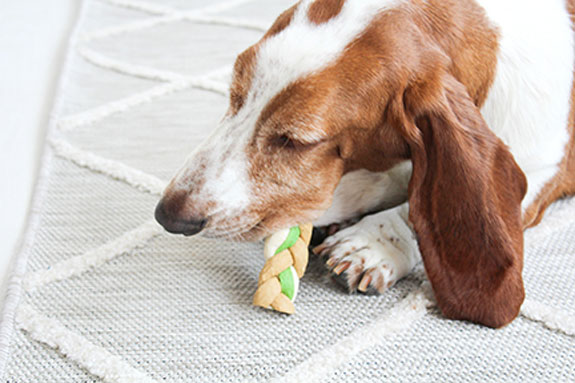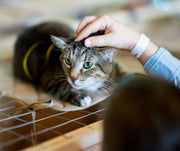How to Prepare your Pet for Post-Pandemic Going Back to Work

The past 12 months have completely transformed the lives of people across the globe. With limited to no access to the outside world or any form of physical human contact for that matter, there is no double that our relationship with our pets has changed. In fact, single and multiple-pet pet adoptions rose to an all time high during the pandemic as single people and families looked for different ways to form relationships and bond with their pets.
After months of hard work and our healthcare workers' continuous efforts, we are finally starting to see a little bit of light at the end of the tunnel. With extreme caution in mind, COVID-19 restrictions are being lifted in several states, and people are slowly starting to return to working from the office. Now, the question arises – How will this affect my pets that have helps me get through this unimaginable nightmare? What can I do to prepare them in advance?
Most pets are creatures of routine. During the months that you spent working from home, they have probably gotten used to having you around the house all the time. So you returning to work and staying away for a long period of time may be a bit of a shock. And even more of a shock for those pet's that were recently adopted and have never been left home alone all day.
Don't worry though! We're here to help. Keep reading for how to prepare your pet in advance, so that when you return to the office, it's not a huge shock for your pet.
PREPARING YOUR PET
Before you dust off those work shoes, put on the coat, drop off your children at school and get back to the office that you've missed for so long, make sure your pet is ready to return to long days without you. Remember, our pets have feeling too and can sometimes be sensitive. Follow these tips to help make the transition as smooth as possible:
Create a Routine: Since your pet has become accustomed to your presence, your sudden absence from the house for prolonged periods of time can cause separation anxiety. You'll need to prepare your pet for this transition in a gradual manner.
Start by creating a routine.
The pandemic and the subsequent lockdown had reduced our inclination to stick to a structured schedule. It's time to change that. Set a fixed time for different activities, including play, exercise, walking, and meals.
Ensure that the routine you set is the same one you will follow once you go back to work. This will allow your pet to get used to the changed lifestyle.
Leave Your Pet Alone: No matter how hard it might be (for you and your pet), you have to start leaving them alone. You can start small. You don't have to leave them alone for the full 8-9 hours from the very beginning. Practice with short departures of an hour or two and gradually increase the duration. Every time you return home, praise your pet for their good behavior and remind them that you will always come home to them.
Readjust the length of your absence, depending on your pet's anxiety and behavior. Remember, it's a learning curve for them. Be patient, continuously monitor their behavior, and keep your expectations realistic.
Start Training: Train your pet early on to remove the anxiety and stress associated with your departure. You can do this by giving your pet small treats or toys to play with every time you leave the house. This will distract your pet and reduce the stress caused by your absence.

Eventually, your pet will feel better and get used to being alone for long periods of time. To help keep their pet entertained while they're away, some pet owners leave the TV on or play some music to distract their pets. You can also engage them in dog-friendly puzzle toys and games that they can play by themselves.
Getting Back to Crate Training: Crate-training might have taken a back seat during the pandemic. You might consider getting back to it. A wire crate, plastic kennel, or any gated space will serve the same purpose. Use reward to make their kennel space more appealing and start leaving your pet alone for short periods of time in the crate.
Feeding Place: Another method to help address separation anxiety is feeding your pet in another room or anywhere else that's away from you. Gradually, your pet may learn that being separated from you can be a pleasurable experience.
More Exercise is the Way to Go: Increase the amount and duration of your pet's exercise time. Take your pet on a walk or jog in the morning before you leave for work. If you have a dog, take him out in the backyard for a game of fetch. If you have a cat, get out the cat wand and enjoy some play time. Excess energy is not always a good thing. It tends to fuel separation anxiety and boredom. If your pet is already tired before you leave, they'll spend more time snoozing and less time stressing. Burning energy will also help your pet remain calm and relaxed.
When you're out walking your pet, do not forget to take the necessary precautions to protect them from any possible health risks. We are not free from the effects of COVID-19, and it is always better to be safe than sorry. Limit or avoid contact between your pet and anyone from outside your household as much as possible.
Pet Daycare: When it's safe, you can revisit the idea of pet daycares. They are a great way to socialize and provide your pet with a safe space to play when you're not around. Make sure that your chosen daycare is taking all the necessary COVID-19 precautions. Do not send your pet unless you are certain that it is safe for them.
Look Out for Anxiety: Keep an eye out for any signs of excessive stress or anxiety. This can include agitation, excessive barking, shaking, pacing, chewing, and other destructive forms of behavior. If you notice this behavior, take a step back from training and give your pet time to adjust to their new normal. If you notice your pet is not getting any better after a few weeks, consult your veterinarian.
CONCLUSION
Remember that your pets are highly observant. If you are stressed about leaving them, they will pick up on it. This may inadvertently increase their anxiety levels. It is crucial to remain calm and patient during this process. If you follow our suggestions and train your pet, they will be ready to cope with your absence when the time comes for you to return to the office.
Your pet has been your support system during these unprecedented times, and now it is your job to make sure they are comfortable and ready for the post-pandemic world.
Previous article

Next article

Related posts
View all-

Keep Your Pets Safe During the Holidays
The holiday season brings joy, festivities, and a break from the usual routine. While you're enjoying the celebrations, it's important to remember that the holidays can present unique challenges for our furry family members. The new sights, sounds, and people can be overwhelming, and common festive items can pose unexpected risks.
Read Article -

Holiday Gifts for Every Pet Personality: The Ultimate Guide
The holiday season is finally here, and for many of us, that means finding the perfect presents for the ones we love most—our pets. Whether they are a steadfast dog who never leaves your side or an independent cat who graces you with their presence on their own terms, our pets are cherished members of the family. They deserve to celebrate right alongside us, stocking stuffers and all.
Read Article -

How to Keep Your Pet Calm During Thanksgiving
Thanksgiving is a time for family, friends, and food, but for our pets, the holiday can be overwhelming. The sudden change in routine, unfamiliar faces and scents, and increased noise can trigger significant stress. Understanding why your pet might feel anxious is the first step toward creating a peaceful holiday experience for everyone, including your furry family members. This guide offers calming tips for pets and practical solutions to ensure your dog or cat feels safe and secure during the festivities.
Read Article



